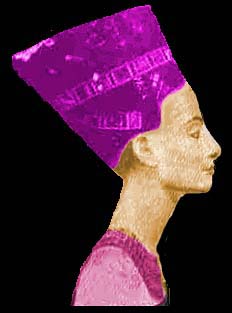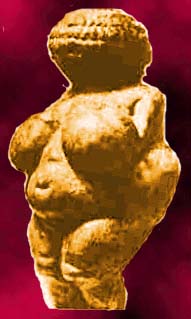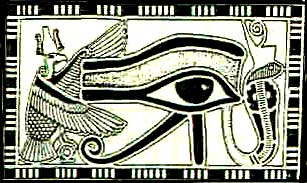



an overview
of
Camille Paglia's
Sexual Personae
Art and Decadence From Nefertiti To Emily Dickinson
Chapter One
SEX AND VIOLENCE, OR NATURE AND ART
"Motherhood Blankets Existence"
"In the beginning was nature. The background from which and against which our ideas of God were formed, nature remains the supreme moral problem. We cannot hope to understand sex and gender until we clarify our attitude toward nature. Sex is a subset to nature. Sex is the natural in man."
"Human life began in flight and fear. Religion rose from rituals of propitiation, spells to lull the punishing elements... Civilized man conceals from himself the extent of his subordination to nature...But let nature shrug, and all is in ruin."
"Sexuality and eroticism are the intricate intersection of nature and culture. Feminists grossly oversimplify the problem of sex when they reduce it to a matter of social convention: readjust society, eliminate sexual inequality, purify sex roles, and happiness and harmony will reign. Here feminism, like all liberal movements of the past two hundred years, is heir to Rousseau."
"The Social Contract (1762) begins: "Man is born free, and everywhere he is in chains." Pitting benign Romantic nature against corrupt society, Rousseau produced the progressivist strain in nineteenth century culture, for which social reform was the means to achieve paradise on earth. The bubble of these hopes was burst by the catastrophe of two world wars. But Rousseauism was reborn in the postwar generation of the Sixties, from which contemporary feminism developed."
![]() "Sex is a far darker power that feminism has admitted.
Sex is the point of contact between man and nature,
where morality and good intentions
fall to primitive urges."
"Sex is a far darker power that feminism has admitted.
Sex is the point of contact between man and nature,
where morality and good intentions
fall to primitive urges."
"Incarnation, the limitation of mind by matter, is an outrage to imagination. Equally outrageous is gender, which we have not chosen but which nature imposed upon us. Our physicality is torment, our body the tree of nature on which Blake sees us crucified."
"Sex is daemonic. This term...derives from the Greek daimon, meaning a spirit of lower divinity than the Olympian gods. The Greek daemons were not evil-or rather they were both good and evil, like nature itself, in which they dwelled."
CATHEXIS: the investment of libido in specific people or things. ![]()
"In western culture, there can never be a purely physical or anxiety-free sexual encounter. Every attraction, every pattern of touch, every orgasm is shaped by psychic shadows."
"To name is to know, to know is to control." The west's quest for form, for control of environment.
"We say that nature is beautiful...What is 'pretty' in nature is confined to the thin skin of the globe upon which we huddle. Scratch that skin, and nature's daemonic ugliness will erupt."
"Our focus on the pretty is an Apollonian strategy... What the west represses in its view of nature is the cthonian, which means "of the earth"-- but earth's bowels, not its surface. I adopt it (the term cthonian) as a substitute for Dionysian, which has become contaminated with vulgar pleasantries. The Dionysian is no picnic. It is the cthonian realitites which Apollo evades, the blind grinding of subterranean force, the long slow suck, the murk and ooze."
Cthonic describes the ugly truth of menstruation, childbirth. "We are born between feces and urine." (St. Augustine) Our modern Apollonian culture protects us from seeing the corpses, the slaughter, the blood. (Sanitary Napkins)
 "Tragedy is the most western literary genre. It did not appear in Japan
until the late nineteenth century...In Greek tragedy, comedy always
has the last word...For life is not a tragedy but a comedy. Comedy is
born of the clash between Apollo and Dionysus. Nature is always pulling
the rug our from under our pompous ideals."
"Tragedy is the most western literary genre. It did not appear in Japan
until the late nineteenth century...In Greek tragedy, comedy always
has the last word...For life is not a tragedy but a comedy. Comedy is
born of the clash between Apollo and Dionysus. Nature is always pulling
the rug our from under our pompous ideals."
(Theatrical)"Tragedy is a male fantasy of free will", an attempt to make the tragic seem more controllable, predictable, inevitable.
"The major women of tragedy...are less moral than men. (Her) will-to-power is naked. Woman introduces untransformed cruelty into tragedy because she is the problem the genre is trying to correct."
"Tragedy's inhospitability to women springs from nature's inhospitability to man. The identification of woman with nature was universal in prehistory."
"The femaleness of fertility religions is always double-edged. The Indian nature-goddess Kali is creator and destroyer, granting boons with one set of arms while cutting throats with the other. The moral ambivalence of the great mother goddesses had been conveniently forgotten by those American feminists who have resurrected them."
Judeo-Christianity is 'sky-cult'. "The evolution from earth-cult to sky cult shifts woman into the nether realm."
"Men, bonding together, invented culture as a defense against female nature."
"The identification of woman with nature is the most troubled and troubling term in this historical argument. Was it ever true? Can it still be true? Most feminist readers will disagree, but I think this identification is not myth but reality."
"Dim memories of life before the traumatic separation of birth may be the source of Arcadian fantasies of a lost golden age...Evolutionary or apocalyptic history is a male wish list with a happy ending, a phallic peak."
"It is against the mother that men have erected their towering edifice of politics and sky-cult.
 She is Medusa, in whom Freud sees the castrating and castrated female pubes.
But Medusa's snaky hair is also the writhing vegetable growth of
nature. Her hideous grimace is men's fear of the laughter of women."
She is Medusa, in whom Freud sees the castrating and castrated female pubes.
But Medusa's snaky hair is also the writhing vegetable growth of
nature. Her hideous grimace is men's fear of the laughter of women."
"Sexuality cannot always be reduced to social models, the attempt is a throwback to 19th century utilitarianism."
"Sex is metaphysical for men, as it is not for women. Women have no problem to solve by sex."
"Women do not need to conceptualize in order to exist."
"No woman has to prove herself a woman in the grim way a man has to prove himself a man'.
"Man is condemned to a perpetual pattern of linearity, focus, aim, directedness. Woman's eroticism is diffused throughout her body."
"The compartmentalizing of male genitality leads to dissociation of sex and emotion."
"Women tend to be less obsessional and more realistic because of their toleration for ambiguity, which they learn from the mystery of their bodies."
"Woman is literally the occult, the hidden."
"Woman's body is a secret, sacred space. It is a temenos or ritual precinct, a Greek word I adopt for the discussion of art. Every woman is a priestess guarding the temenos of daemonic mysteries. Virginity is categorically different for the sexes. A boy becoming a man quests for experiences. The penis is like eye or hand, an extension of self reaching outward. But a girl is a sealed vessel that must be broken into by force. The female body is the prototype of all sacred spaces from cave shrine to temple and church."
"Modern feminism's most naive formulation is its assertion that rape is a crime of violence but not of sex, that it is merely power masquerading as sex. But sex is power, and all power is inherently aggressive. Rape is male power fighting female power. It is no more to be excused than is murder or any other assault on another's civil rights. Society is woman's protection against rape, not, as some feminists absurdly maintain, the cause of rape."
LesBiGay phenomena "demonstrate basic gender tendencies at their extremes: male satyriasis and female nesting."
"Art is a ritualistic binding or freeze frame of the perpetual motion machine that is nature."
Art=Ritual...Sex Object=Art Object
"Paganism is eye-intense." 
"Pornography is pure pagan imagism."
"The idea that emotion can be separated from sex is a Christian illusion."
 "Desire is intensified by ritual limitations."
"Desire is intensified by ritual limitations."
"The west objectifies persons and personifies objects."
"Art is form struggling to wake from the nightmare of nature."
Chapter Two
The Birth of the Western Eye
APOTROPEIA: Devices for warding, hex signs, the Hand of Fatima,
Eye of Horus.
"Egypt invented the magic of image."
"Heirarchy and eroticism fused in Egypt for the first time."
The hard glossy line of Egypt; the first effective supression of female interiority. Flat wall paintings.
"Egyptians were the first aesthetes, with 'taste', living by the eye. They saw edges. They invented elegance- reduction, simplification, condensation, sleekness."
"Only in the Egyptian cosmogeny are earth cult and sky cult fused. Because of life dominated by the Nile..." The inhabitable Nile valley a sleek line: water flanked by desert- 5 miles wide and 600 miles long.
Sacred space; the heirarchic sequestration of the Egyptians: cat worship.
"Cats are autocrats of naked self interest."
"The cat may be the only animal that savors the perverse or reflects on it."
"The cat is eye-intense. It is a narcissist, always adjusting its appearance. They have a sense of pictorial composition, arranging themselves symmetrically."
"They are laws unto themselves. Cats are secretive, capable of ambivalence, its ears listening to a distant sound while its eyes falsely rest on us."
"Cats fuse Apollonian and Cthonian, thus through them Egypt defined its aesthetic."
"The cat, fixing its swift predatory energy in poses of Apollonian stasis, was the first to enact the frozen moment of perceptual stillness that is high art."
 The "Venus of Willendorf", a 4 3/8"
stone figurine dating from 30,000 B.C. that was found in Austria.
"In it we see all the strange laws of primitive earth-cult."
"Her fat is a symbol of abundance in an age of famine."
"Venus of Willendorf is eyeless because nature can be seen but not known."
"Bulging, bulbous, bubbling. Venus of Willendorf, bent over her
own belly, tends the hot pot of nature. She is eternally pregnant. She
broods, in all senses. She is hen, nest, egg...She is turgid
with primal force, swollen with great expectations. She is woman
as earthen ovals, woman as quivering poached egg."
The "Venus of Willendorf", a 4 3/8"
stone figurine dating from 30,000 B.C. that was found in Austria.
"In it we see all the strange laws of primitive earth-cult."
"Her fat is a symbol of abundance in an age of famine."
"Venus of Willendorf is eyeless because nature can be seen but not known."
"Bulging, bulbous, bubbling. Venus of Willendorf, bent over her
own belly, tends the hot pot of nature. She is eternally pregnant. She
broods, in all senses. She is hen, nest, egg...She is turgid
with primal force, swollen with great expectations. She is woman
as earthen ovals, woman as quivering poached egg."
"is the Venus of Willendorf just to female experience? Yes. Woman is trapped in her wavy, watery body...The pregnant woman is daemonicallly, devilishly complete. I will argue that it is not menstrual blood per se which disturbs the imagination- unstanchable as that red flood may be- but rather the albumen in the blood, the uterine shreds, placental jellyfish of the female sea."
 Bust of Nefertiti, 1375-57 B.C.; limestone and plaster,
the eye is inset rock crystal.
Bust of Nefertiti, 1375-57 B.C.; limestone and plaster,
the eye is inset rock crystal.
The sleekness of Nefertiti. Egypt invented the 'bust' as sculpture. "As we have it, the bust of Nefertiti is artistically and ritualistically complete, exalted, harsh, and alien."
"Nefertiti is femaleness made mathematical, femaleness sublimized by becoming harder and more concrete."
"The Idea of beauty is based on enormous exclusions."
"Nefertiti, like the cat, sees in and out."
"Art is a window of appearance. The frame is a victory over nature."
Chapter Three
Apollo and Dionysus
"Greece splits sky cult and earth cult." The gods are on Mount Olympus.
The Apollonian rises above the muck, in focused sleekness. The Dyonysian writhes in sensuous decadence, sucking all into its slathering cthonic maw.
"The Greeks never worshiped beast gods."
"Apollo was originally a wolf god: Apollo Lukeios. He changed through history from bearded man to ephebic youth in the process of being cleansed of the cthonic."
The emergence of androgyny, Artemis. The Amazon is the female version of the castrati, her breast 'pinched off' by her bowstring and battle garb."
The glossed over violence of the Dionysian orgy, revenge of an androgynous cthonic. The scattering of limbs by the maddened queen Agave and her maenads, called in Greek sparagmos.
City goddesses were virgins, an allusion to the impregnability of the city.
Venus Barbata and Venus Calva (bearded and bald Venus) worshipped by men in transvestite garb in pagan times.
The Rest of the Book
Discussions of Various Authors
The Awakened Eye
Edmund Spenser's "Faerie Queene", written in 1590. A literary Botticelli. Introduced the Apollonian line to English literature. He split from Chaucer's clunky Christianity, turning to pagan style. Chaucer was a populist, Spenser was a hierarchist. He uses voyeurism as the technique of avoiding the cthonic swamp. Chastity, brightness, clarity, strength in women. The "Bower of Bliss", a sheltered, heavenly safe place.
Rousseau Vs. Sade
The Marquis de Sade (1740-1814) A reversion to the great mother. He faces the
cruelty of nature, asserts natural selection.
Jean Jaques Rousseau (1712-1778) The romantic, hopeful world view. The
anti-establishment stance. Masochistic subordination to the idealized female.
Goethe
Goethe (1749-1832) Half classic and half romantic. Christianity raised the significance of lust, compartmentalized it. Suspension of sexual ambiguity.
Sex Bound and Unbound
William Blake (1757-1827) Seeks to abolish guilt and covertness in sex.
"Blake is the English Sade and Emily Dickinson is the
American Sade. He turns sex and psyche into a Darwinian cycle of turbulent natural
energies, fleeing, chasing, devouring." He tries
to free sex of social constraint but also avoids the great mother.
"Hovering menace" motif in his art.
![]() (Here is a sketch of Blake's cosmology: Our fallen realm is divided into
the two entities, "Emanation" and "Spectre". Emanation is projected
cathexis (energy invested in some specific entity),
usually female. It must be manifested outwardly or problems
arise. If it is projected too far out, it becomes Spectre, the
spectre of rationalism has intervened. Spectre is always male.)
(Here is a sketch of Blake's cosmology: Our fallen realm is divided into
the two entities, "Emanation" and "Spectre". Emanation is projected
cathexis (energy invested in some specific entity),
usually female. It must be manifested outwardly or problems
arise. If it is projected too far out, it becomes Spectre, the
spectre of rationalism has intervened. Spectre is always male.)
William Wordsworth (1770-1850) A Rousseau-ish hopefulness about nature, and avoidance of the cthonic. Marriage to mother nature.
Samuel Taylor Coleridge (1772-1834) (The Rime of the Ancient Mariner, Christabel) Reveling in the amoral, smashes Wordsworth, subsequent guilt, 'extremes meet.'
Speed and Space
Byron (1788-1824) Second generation romantics, skimming over femininity, the purgation of the female. The curling romantic lip of decadence.
Percy Bysshe Shelly (1792-1822) Epipsychidion. An attempt to go back to the womb while staying angelic. Idealization, projection.
Keats (1795-1821) Male as nurturer.
Cults of Sex and Beauty
Balzac, Gautier, Baudelaire, Huysmans- Decadence drenched in sex, but sex as thought rather than action.
Romantic Shadows
The Bronte sisters, Emily and Charlotte, Wuthering Heights and Jane Eyre respectively. Wuthering Heights filled with complex incestuous relationships. Re-rooting of Shelly and Byron in cruel nature.
The Beautiful Boy as Destroyer
Oscar Wilde (1856-1900) The authority of sequestration. Objects are alive, people are objects, decor. Fascination, charisma. Physical beauty as dominance. Emotion is deflected into a mannerist torsion. Caste system, suspension of natural law as in Lewis Carroll's "Alice in Wonderland'. Epigrams- one-liners. The androgyne of manners, verbal swordplay. Slaves to fashion.
American Decadents
Hawthorne (1804-1864)- Nathaniel's tales ponder the uneasy
relation between Christianity and the female.
Melville (1819-1891) Moby Dick's hyper masculinity obscures the femaleness
of nature.
Emerson- The giant eyeball- woman supressed.
Whitman- Seeks to scandalize the status-quo, more voyeurism.
William James - Everything indefinite, a fog of vague ornamentation, concealing a deep connection to Coleridge.
Emily Dickinson- Twisted, passive-aggressive, Amherst's Madame de Sade.
Again: This is only scratching the surface. If a thought seems incomplete or not fully supported, keep in mind that for each sentence on this page, the book has pages more. (673 pages text, 43 of notes.) The book is as packed with gems as it is here; each sentence leaping off the page in a flash of light... Her newer work follows the thread from Dickinson up to Jagger, Madonna, and O.J. More material in that vein is on its way. While you're waiting, check out some of Dr. Paglia's comments on 'Political Correctness'.
If you like Camille Paglia, you'll also like Irma Kurtz